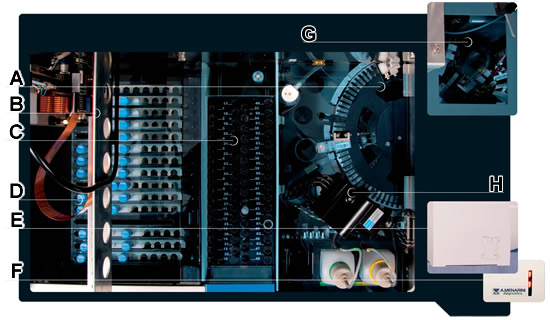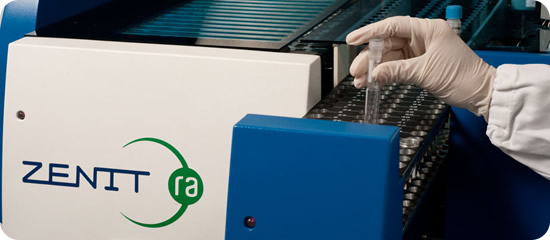
| A. |
A thermo-regulated carousel set at 37°C with 90 positions for disposable cuvettes. A spectrophotometer for measuring absorbance in certain immunoassay reactions is incorporated into the carousel |
| B. |
A pipetting arm that pipettes both reagents and samples |
| C. |
A sample tray with 64 positions for samples, calibrators and controls |
| D. |
A refrigerated reagent compartment, consisting of 15 rails containing the immunoassay reagent racks. The reagent cartridges are stored in the refrigerated reagent compartment between 12 and 15°C while the analyzer is operating, and between 8 and 10°C in standby mode |
| E. |
An automatic cuvette loader, holding 960cuvettes at a time (pre-formed as a cube) |
| F. |
Two barcode readers (one located on the front face of the analyzer, the other integrated into the reagent compartment) identify samples, ancillary reagents and reagent cartridges |
| G. |
Four washers for washing magnetic particles |
| H. |
A luminometer measuring luminescence in immunoassay reactions (directly in the cuvette) |
AN INNOVATIVE OPERATING PRINCIPLE CLIA (Chemiluminescence enzyme immunoassay) based tecnology
The assay is based on a two-step indirect chemiluminescent method that generates quantitative results. This particular technique uses autoantigen-coated magnetic particles as solid phase and an antibody labeled with a dimethyl acridinium ester (DMAE) as detection marker. The use of high quality antigens and large coated surfaces provides excellent sensitivity in
Zenit RA immunoassays.
- In the first incubation phase, specific autoantibodies present either in the sample, calibrators or controls bind to the immobilized antigen
- In the second incubation phase the DMAE conjugate reacts with the coated magnetic particle-autoantibody complexes
- Non-bound material is washed away after every incubation step
- Chemiluminescence is activated by the addition of trigger solutions:
A (hydrogen peroxide) and B (an alkaline solution), resulting in oxidation of the ester to an excited form. Return to a stable state is accompanied by the emission of light, which is measured and expressed in Relative Light Units (RLU)
- The signal is directly proportional to the concentration of specific autoantibodies in the samples, calibrators or controls

AN OPTIMIZED WORKFLOW
Let’s push the start button…
- Samples and reagents are aspirated using a probe equipped to detect liquid level using capacitance. The sample and reagents are pipetted in accordance with the validated parameters for each assay and transferred into a cuvette where the reaction takes place
- Reaction cuvettes are then incubated on the carousel at 37°C for 10 minutes
- The probe is rinsed internally and externally between each sample to eliminate any risk of contamination
- The cuvettes are transferred to the washing module where magnets hold the solid phase (magnetic particles) during washing
- Conjugate is added to the cuvettes and they are transferred to the carousel for another incubation at 37°C for 10 minutes
- After this last incubation step, another washing is performed in the washing module as mentioned earlier
- The cuvette is then transferred to the luminometer where trigger reagents are added to produce luminescence
- When measurement is complete, cuvettes are automatically ejected into a re-usable solid waste tray

THE KEY FEATURES AT A GLANCE
Flexibility
- Various work modalities: Random access, batch mode and STAT priority function for urgent samples
- Up to 15 different simultaneous immunoassays
- Continuous access to samples, reagents, consumables and parts
- 64 positions for samples, controls or calibrators
- Several disciplines can be processed in one run (Autoimmunity but also Infectiology)
- Patient-specific test profiles
- On-board dilution and pre-treatment of samples
- Calibration stable for 4 weeks
- Asynchronous management of samples
- Reagent cartridges on board in a refrigerated area
- Primary and secondary tubes accepted: 5, 7, 10 ml tubes and pediatric micro-cups
- Reflex testing capability
Accuracy, Reproducibility…
- Highly reliable results:
- Stored master curve
- 2-point recalibration method
- Use of coated-microparticles instead of classical coated-cuvettes (providing more uniform and extensive coating)
… and quality/safety of the results
- Flashing light drawer-system (to prevent interruption of procedures and safeguard results)
- One cuvette per test (to avoid potential cross contamination)
- Probe rinsing between each sample
- Clot detection system

Efficiency
- Short time to first result: within 25 minutes
- High throughput: 70tests/hour
- Continuous loading of bar-coded samples and reagents for peak workloads
- Workload management for optimal throughput: ideal for labs performing 50 to 400tests per day
- Sample volumes as low as 4 μl in some assays
- Calibrators and controls included
- Ready to use reagent cartridges
Simplicity
- Load and walk away (960 cuvettes on board, automatic cuvette loader, ancillary reagents on board for more than 1000 tests)
- Intuitive user interface
- Barcode reading for all reagents and samples
Computerized functionality
The analyzer is connected to a computer via an Ethernet link.
Workflow is programmed with dedicated software that performs the following functions:
- Management of reagent, calibrator and control lots
- Quality controls (Levey-Jennings and Westgard)
- Management of ancillary reagents
- Full traceability of samples, reagents and operators
- Transfer of results to a centralized computer system
- Automatic wakeup and shutdown
- Remote maintenance connection
Lab-Friendly design
- Small size (L 105 cm x H 70 cm x W 75 cm)
- Benchtop
- Flashing light drawer-system